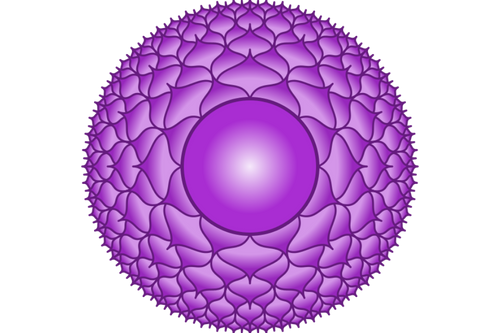Different traditions and cultures understand and identify the number of chakras and their characteristics in different ways. The things they all seem to agree on are:
- The main chakras are located within our body and run along our spine, except for two of them, as I’ll explain later on;
- What their main functions are.
I respect those traditions that explain and understand the chakra system differently than the school of Western tradition I come from. What I share here is the knowledge and understanding I have acquired through my research and studies, thanks to conversations and training with esotericists, mystics, and masters as well as through first-hand experiences.
A chakra is a center of pulsating and rotating energy, according to the Sanskrit word for chakra, चक्र, meaning wheel, circle, or point. The Western tradition identifies seven chakras, positioned in several areas within our system. Each chakra has a specific vibration, which translates into specific colors and sounds, and a specific function.
Before describing each chakra, let’s imagine that our spine, which runs right through the middle of our body, extends energetically outside of our body both upwards (above our head) and downwards (toward the earth). You can visualize it as a beam of energy that keeps human beings connected to both aspects of their dualistic nature, the earthly/materialistic side, and the heavenly/spiritual side.
As you read through the following classification, be aware that the differentiation between chakras has to be appreciated flexibly. This means that the chakras are interconnected and they influence each other. So, for example, a problem in the space of chakra 4 can have its origin in chakra 2. Therefore, a heart problem (corresponding to chakra 4) can be caused by a childhood trauma related to abandonment (involving chakra 2). The structures we create around things only respond to our human need to identify and separate in order to understand and control. Experience, which is another way of acquiring knowledge, shows us that there is no separation and that everything dances in harmony with the rhythm of our heart, which is the same as the rhythm of nature and the universe.

Chakra 1: The Root Chakra
Position: The root chakra is one of two chakras that do not belong within our physical body, however they influence our physical body. You can imagine that the first chakra is about 15 cm underneath your pelvis along the axis of energy mentioned above.
Vibration: The vibration of the root chakra corresponds to the color red and produces the musical note C.
Function: This first chakra promotes and nurtures your mental and physical stability. It connects you to mother earth, grounds you, and makes you feel secure. This chakra is responsible for the health of your gut, your reproductive system, your urinary tract and bladder, men’s prostate, your colon, your lower belly, and your legs and feet. Therefore, when this chakra is not balanced you can experience physical problems in those areas. Also, eating disorders and anxiety disorders are symptoms of a malfunction of the root chakra.

Chakra 2: The Energy Chakra
Position: You can position the energy chakra just underneath your belly button.
Vibration: The vibration of the energy chakra gives it the color orange and musical note D.
Function: This second chakra is in charge of your creativity, as well as the actual ability to create life (or procreate), as it is involved in the development of the fetus into a fully formed and functioning baby. The second chakra stores very strong historical emotions, pertaining to the months spent in your mum’s womb, the first few years of this current life, memories from previous lives, and the collective subconscious.
Besides sharing the responsibility of the reproductive system with the first chakra, this chakra is also responsible for the health of part of the colon, the lower part of the stomach, and the lower back. A balanced second chakra leads to feelings of wellness, abundance, pleasure, and joy. When this chakra is out of balance, we may experience emotional instability, fear of change, sexual dysfunction, depression, and addictions.

Chakra 3: The Emotions Chakra
Position: The third chakra is situated in your solar plexus, roughly at the entrance of your stomach.
Vibration: The vibration of the third chakra gives it a bright yellow color and the musical note E.
Function: It is the emotions chakra that is responsible for managing your daily emotions from the external world as well as those that are generated internally. Imagine the third chakra like a seaport where ships carrying all types of emotions moor, offload, upload, and sail off again. When the traffic is too high, and the bay gets too crowded, that is when this chakra starts struggling to function properly. This impacts mainly the health of the stomach and, based on the types of emotions you are dealing with, it can have reverberations on the liver, the pancreas, and the spleen.
At a subtle level, when the third chakra works well we feel self-confident, motivated, and have a strong sense of purpose. When it doesn’t work well, you’ll experience low self-esteem, repressed or expressed anger, and emotional control issues.

Chakra 4: The Heart Chakra
Position: This chakra is located in the center of our chest, our heart space.
Vibration: The vibration of the heart chakra gives it a green color and the musical note F.
Function: The fourth chakra is key for our evolution. It represents the strongest energy in the universe: love. The fourth chakra represents the bridge between the earthly and the spiritual. Activating the fourth chakra, opening your heart, is the precondition to any spiritual experience and the secret to living a happy life. This chakra is responsible for the health of our cardiac plexus, thymus gland, lungs, and breasts. When this chakra is unbalanced, at a physical level we can experience any type of heart condition, breathing difficulties (allergies to pollen are an example of a malfunctioning of the heart chakra), and deficiencies in our immune system.
At a subtle level, our connection with our spirituality may suffer, we might have difficulties in forgiving ourselves and others, and hold a lot of resentment. The feelings and emotions of an active fourth chakra are compassion, love, acceptance, forgiveness, equanimity, equality, a sense of oneness, generosity, expansion, and openness. How glorious!
Please note: the opening and usability of the following chakras (called the spiritual chakras) depend on the activation of the 4th chakra. Without opening your heart, you will not have access to the superior spheres. You can certainly learn how to manipulate energy but access to higher knowledge and powers will be denied.

Chakra 5: The Throat Chakra
Position: The fifth chakra is located in our throat.
Vibration: The vibration of the throat chakra gives it a deep blue color, sometimes shaded with green or indigo. It produces the musical note G.
Function: The fifth chakra is the first of the three spiritual chakras, responsible for the communication with your higher self and the development of clairaudience which enables you to receive and send information through the quantum grid.
This chakra is responsible for the health of the thyroid, neck, jaw, larynx, mouth, and tongue.
A well-attuned fifth chakra enables you to speak your truth openly and confidently, and build and nurture your inner dialogue. It strengthens and refines your ability to listen to yourself and others, and enables you to express yourself clearly and completely. When this chakra is open you can communicate with compassion and receive information from your higher self and the higher spheres.
When this chakra is not well aligned, you might experience physical problems such as mouth ulcers, throat aches, hypo, or hyper-thyrodism. At a subtle level, you will feel anxious or even afraid to speak (in public or not), unable to communicate your needs or to explain what you think or how you feel.

Chakra 6: The Third Eye (or First Eye)
Position: You can locate the sixth chakra in between your eyes, in the center of your head. This is also the area of the third eye.
Vibration: The vibration of the sixth chakra gives it an indigo color and produces the musical note A.
Function: The sixth chakra is responsible for the health of your pineal and pituitary gland, eyes, head, and lower part of your brain. This chakra is the center of intuition, the cradle of your third eye. The second of your spiritual chakras promotes inner knowledge and higher guidance. When balanced, the sixth chakra provides clarity of vision that helps you make decisions that are in line with your true nature. You are able to see through people and situations, and can feel as if you already know how situations will pan out – you develop a sixth sense. An open sixth chakra facilitates visualization and can enable clairvoyance, telepathy, lucid dreaming, and expanded imagination.
When your sixth chakra is imbalanced, you might have problems with your sight, headaches, migraines, you could gain weight, high blood pressure, low sex drive, and mood swings. At a subtle level, your intuition is suffering, so making choices can be a real challenge and you could find it very difficult to make decisions that serve your best interest.

Chakra 7: The Crown Chakra
Position: This is the second chakra that is not actually located within our physical body. You can imagine this chakra to fluctuate at about 15 cm above the center of your skull, along the axis of energy mentioned at the beginning.
Vibration: The vibration of the crown chakra gives it an intense and bright purple color and produces the musical note B.
Function: This chakra is our portal to the divine, our connection with spirituality and the universal consciousness. It is what makes the human being complete.
The seventh chakra promotes a search for a higher purpose and elevated emotions and attitude. It is the gateway to super-consciousness, where there is no separation (which is but an illusion). When your seventh chakra is active, you experience yourself as one with everything and everyone around you. When your crown chakra is aligned, you are open to receiving clear information as to who you are and why you are here.
When it works well you feel connected with everything and everyone, and your emotions are those of peace, love, tolerance, unity, harmony, and balance.
If your crown chakra is not active, you may be feeling unstable in your physical body, experiencing coordination issues, and might experience physical impairments. Mentally, you feel confusion, loneliness, and a lack of focus.
Whenever you feel unbalanced or experience physical and non-physical ailments due to the malfunctioning of one or more chakras, meditation can help you reestablish balance and realign the chakras. This brings immediate relief which will last longer the more you practice it—ideally, on a daily basis or as a regular discipline. Another efficient way to operate on and through the chakras is certainly any one of the many types of Yoga practiced and taught worldwide today.
Through meditative and/or yogic techniques specifically meant to rebalance the chakras, both your physical and mental health can be restored, and harmony re-established.

Book a one-on-one session with Val Pelt here







